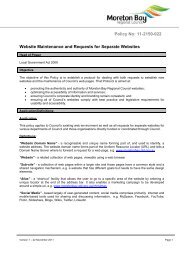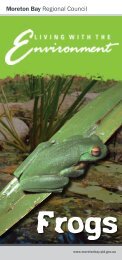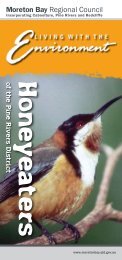(Use this booklet with the Habitat Trees poster) - Moreton Bay ...
(Use this booklet with the Habitat Trees poster) - Moreton Bay ...
(Use this booklet with the Habitat Trees poster) - Moreton Bay ...
Create successful ePaper yourself
Turn your PDF publications into a flip-book with our unique Google optimized e-Paper software.
NOCTURNAL (night time)113232454566779889101110111212131314Old native trees (eg. gums, rainforest trees and mangroves) <strong>with</strong>many hollows, cracks and crevices are called habitat trees.
Frequently, in urban areas, habitat trees and dead old treesare felled or severely cut back. This is because of fears thattrunks or limbs could fall and kill or injure people or pets;or damage property.Because old trees often host colonies of termites (‘whiteants’), people are afraid that <strong>the</strong>se could damage buildings.Most termite species do not attack timber in buildings.The few species which attack sound wooden structures areusually <strong>the</strong> subterranean kinds that do not build visible nests.These may travel underground for up to 80 metres. Removalof a particular tree may have no effect at all in protecting abuilding from termites. Tree removal can give a false senseof security. Proper precautions and regular inspections at <strong>the</strong>site of <strong>the</strong> building are <strong>the</strong> best protection against termites.6Termites that build arboreal moundsdo not harm sound buildings
Because of <strong>the</strong>ir great importance to <strong>the</strong> natural environment,it is essential to plan to prevent problems that may arise <strong>with</strong>habitat trees. We should avoid locating buildings, paths andtracks near trees that may become dangerous. There are waysof avoiding dangers posed by old trees, o<strong>the</strong>r than <strong>the</strong> drasticoptions of lopping or removal. If a habitat tree is not close tobuildings or places where people frequent, <strong>the</strong>y should betotally protected.<strong>Habitat</strong> trees are an important part of our natural heritageand are among our most valuable environmental assets.They are virtually irreplaceable and should be retainedwhenever possible.Every old gum tree becomes a more valuable habitat tree asit ages. In <strong>the</strong> future, when we become more aware of <strong>the</strong>real value of habitat trees, <strong>the</strong>ir presence will significantlyincrease <strong>the</strong> monetary value of a property.Termites that build large terrestrial mounds eat only grass7
• Cracks, crevices, notches and hollows. These are habitatsand micro-habitats – breeding sites, shelter, refuge,and living quarters for a wide range of animals.In <strong>the</strong> <strong>Moreton</strong> <strong>Bay</strong> region, more than 31 native mammals,14 reptiles, 6 amphibians and 60 bird species use <strong>the</strong>seresources. Cymbidium orchids (3 species), now becomingless common in many areas, also depend on old trees for<strong>the</strong> cracks and hollows in which <strong>the</strong>y live.Native cymbidiumorchids need old ordead trees for habitatPale-headed Rosella –many Australian birdsbreed in hollow limbs(Photo: N. Male)• High branches. This is where some birds (eg. <strong>the</strong> Osprey,eagles, kites and o<strong>the</strong>r raptors) prefer to build <strong>the</strong>ir nests.Many raptors build nestsin tall, dead treesSome raptors build intall, living trees8
• Dead branches above <strong>the</strong> canopy. Some birds use <strong>the</strong>sefor roosting, sunning and preening. Good all-round visiongives protection against sudden approach by predators.Predators may also use <strong>the</strong>se branches for <strong>the</strong>se reasons,and to watch for prey. High, dead branches provideroosting and lookout sites.Australian MagpieWhistling Kite• Large quantities of food for wildlife. Mature, large oldtrees provide plentiful food – nectar, pollen, exudate(sap), fruit, seeds, leaves, wood and litter – for animals ofmany kinds; and food for plants such as fungi, algae,lichens and native orchids.• Large surface areas of trunks and branches of habitattrees provide extensive hunting sites for animals whichfeed on organisms that live on <strong>the</strong> bark.Feeding pattern ofRed-triangle Slugs on asmooth-barked gum treeWhite-throatedTreecreeper – feeds onbark-living animals• Large surface areas of leaves. Leaves carry outphotosyn<strong>the</strong>sis (combining water and carbon dioxidevia sunlight to make organic compounds and oxygen) andtranspiration (release of water into <strong>the</strong> atmosphere).9
• Canopies create large areas of shade and shelter.Beneath large old trees soil temperatures and moisturelevels are more stable – providing better habitat forsoil organisms.• The large amount of carbon dioxide removed from <strong>the</strong>atmosphere is stored as wood. Decreasing <strong>the</strong> amountof carbon dioxide in <strong>the</strong> atmosphere helps lower <strong>the</strong> rateof global warming.• Big habitat trees release large amounts of oxygen toenhance <strong>the</strong> quality of air we brea<strong>the</strong>.• <strong>Habitat</strong> trees transpire large quantities of water to clean,moisten and cool <strong>the</strong> air we brea<strong>the</strong>.• A large wide canopy protects <strong>the</strong> soil from rain wash,and <strong>this</strong>, toge<strong>the</strong>r <strong>with</strong> bigger quantities of leaf litter,slows <strong>the</strong> loss of moisture via evaporation, increasinginfiltration of water into <strong>the</strong> soil. Streams in forests arethus more likely to be permanent, and flood peaks lower.• Litter from large areas of canopy protects and enriches<strong>the</strong> soil and provides habitat and food for microorganisms,worms, snails and slugs, insects, arachnids, frogsand lizards.• Deep roots draw nutrients from greater depths, andtransfer <strong>the</strong>se to <strong>the</strong> soil surface in leaf fall, makingfood available to smaller plant species.• Deep roots keep <strong>the</strong> watertable low and decrease <strong>the</strong>chances of soils becoming waterlogged or saline.• Hollow tree trunks and limbs are breeding sites for owls,hawks, and o<strong>the</strong>r birds that forage in surrounding fieldsfor grasshoppers, mice, rats, hares, rabbits and feral cats.• Birds that nest in hollows (eg. kingfishers, kookaburras,pardalotes, <strong>the</strong> Dollarbird, treecreepers and shrikethrushes)eat and control a vast array of insects.• Many species of insectivorous bats (microbats) whichshelter under bark and in hollows and cracks eat greatnumbers of insects, such as mosquitoes, mothsand termites.10
• Marsupials (such as possums, gliders, antechinuses and<strong>the</strong> Brush-tailed Phascogale) that nest in hollows includemany large insects in <strong>the</strong>ir diets. Insects (such as beetles,grasshoppers, crickets, wood moths and stick insects),when not controlled by predators, add to problems ofdieback in our native trees.• Treefrogs, geckos and arboreal (tree-dwelling) skinks,that shelter and take refuge in cracks, crevices andhollows of habitat trees, control many insects such asmosquitoes, flies, moths and termites.Hollows may occur from low in trunks to high in <strong>the</strong> branches• Some large birds (eg. cockatoos and <strong>the</strong> Powerful Owl)and large marsupials (eg. possums and <strong>the</strong> Greater Glider)need large hollows for nesting and/or shelter.Large hollows are usually found only in <strong>the</strong> older trees.Several hundred years may be required for <strong>the</strong>se largehollows to develop.Large hollows take hundreds of years to develop• Tall old trees, well-adapted for survival in <strong>the</strong> localenvironment, produce seeds for future generationsof <strong>the</strong>se locally-adapted plants.11
(to protect wildlife, and avoid dangerous falling limbs)• Fence off isolated habitat trees that may pose a dangerto stock if limbs fall. Old trees (and younger ones) willremain healthier and live longer if stock do not ga<strong>the</strong>raround and compact <strong>the</strong> soil, concentrate nutrients,and damage <strong>the</strong> bark.Cattle seeking shelterhas lead to <strong>the</strong> deathof <strong>this</strong> lone old nativegum tree, now replacedby a Camphor Laurel, aweed that better toleratescompaction and highnutrient levels• Do not fell habitat trees (alive or dead) to use asfenceposts or firewood. <strong>Use</strong> younger trees of suitablespecies (ideally plantation grown) for <strong>the</strong>se purposes.Younger local trees need to be retained to replace <strong>the</strong> oldtrees that are eventually lost – even small hollows takemore than 100 years to develop.• Allow <strong>the</strong> offspring of habitat trees to regenerate insurrounding fenced-off areas. When old trees die we lose<strong>the</strong>ir valuable and irreplaceable genetic potential.• Decrease <strong>the</strong> fuel load around habitat trees between Mayand August (before <strong>the</strong> fire season). This helps to protect<strong>the</strong>m from hot fires that could destroy <strong>the</strong>m at o<strong>the</strong>r timesof <strong>the</strong> year.A burning hollow tree.Many habitat treesare lost in hot fires12
• Retain or replant groups and corridors of local native treesas shade and shelter for stock. These will be more usefulthan isolated trees, and less impacted by stock.• Retain habitat trees and large dead trees near cultivatedpaddocks so that hawks, eagles and owls, and o<strong>the</strong>rpredators of mice, rats, hares, foxes and pest insectswill use <strong>the</strong> trees for nesting, roosting and as lookoutsites. These natural predators decrease <strong>the</strong> need for costlyand environmentally-damaging pest control measures.• Retain habitat trees and dead trees <strong>with</strong>in groups of localnative trees. Gliders, possums, phascogales andinsectivorous bats will use hollows in <strong>the</strong>se treesfor shelter and refuge, and control leaf-eating insectsin surrounding trees. Native predatory animals, includingpredatory insects, help prevent <strong>the</strong> onset of dieback in ournative forests, caused partly by leaf-eating insects.• In parks and reserves, use wildlife-friendly fencing tofence-off habitat trees and dead trees that pose adanger to people if trunks or limbs fall. Signage canprovide information about <strong>the</strong> significance of <strong>the</strong>se treesand <strong>the</strong>ir importance to native animals.• Locate tracks and paths (for bikes and walking) away fromhabitat trees and old dead trees.• In parks and reserves, retain or restore areas of naturalvegetation around and under habitat trees. Animals, someof which are natural predators of insects and o<strong>the</strong>rorganisms that damage trees, need native vines,understorey shrubs and groundcovers. These predatoryanimals aid <strong>the</strong> survival of old trees.Silkpod and MonkeyRope vines flower whenfew o<strong>the</strong>r plants do.Their nectar is food fornative wasps that controlgumleaf-eating andwood-eating grubs13
Most native birds and o<strong>the</strong>r animals do not live incleared and mown open spaces. However, many exoticanimals do – Sparrows, Starlings, Indian Mynas,Spotted Turtledoves and feral pigeons. These areasalso favour open-area and edge-living native birds,such as Australian Magpies, Butcherbirds, NoisyMiners, and Masked Lapwings. Some of <strong>the</strong>se birdscan become aggressive towards smaller birds, andsometimes towards humans.Common (pest) Starlingsuse tree hollowsCommon Mynas useand spoil tree hollows• Re-route existing tracks and paths (for bikes and walking)away from habitat trees so that people are not led into‘danger’ areas. This may be costly, but hundreds of yearsof growth have gone into producing <strong>the</strong>se critical naturalresources. Planted replacement trees are not <strong>the</strong> answer.What price do we put on <strong>the</strong> survival of our uniqueAustralian fauna which depend on habitat trees?• Locate tables, barbeques and playground equipmentunder open shelter sheds, or around local native treesplanted specifically for <strong>the</strong> purpose, ra<strong>the</strong>r than nearhabitat trees which may pose dangers of falling branches.• <strong>Use</strong> no mulch near trunks of trees, and no excavation,concrete or bitumen <strong>with</strong>in <strong>the</strong> dripline.• Design urban development layouts to ensure natural areas<strong>with</strong> significant numbers of habitat trees and dead treesare retained as part of common land or in public reserves.14
• Parking facilities should be designed so that vehicles areseparated from habitat trees by landscaped areas of localnative groundcovers and shrubs.Good park design (at Andy Williams Park, Cedar Creek)to protect <strong>the</strong> habitat tree, <strong>the</strong> parked vehicles, and people• On building blocks, locate houses and o<strong>the</strong>r buildingswell away from habitat trees and retain <strong>the</strong>se trees in saferplaces such as in back corners of large yards.<strong>Habitat</strong> trees and wildlifecan be doomed by poorlyplanneddevelopmentThis habitat tree neededpruning to make itsafe for pedestrians –because <strong>the</strong> path waspoorly sited• Realise that <strong>the</strong> chances of branches falling andhitting people are less than <strong>the</strong> chances of beingstruck by vehicles (especially if <strong>the</strong> above precautionsare observed).15
1. Do everything possible to save habitat trees fromdestruction. The removal of a habitat tree (or parts of it)should be only as <strong>the</strong> very last resort.2. Install nest boxes suitable for a range of native animals.For fur<strong>the</strong>r information and plans for building nest boxes,see council’s multi-award winning book, Living With TheEnvironment in <strong>the</strong> Pine Rivers Shire.Bat boxGlider boxSuitable nest boxes can be useful for wildlife that use hollowsThe provision of nest boxes never compensates for <strong>the</strong>destruction of old trees. Nest boxes never fully replace <strong>the</strong>variety of natural hollows and <strong>the</strong> diverse micro-environmentsin habitat trees.3. Engage a professional apiarist or pest controller to removeferal honeybees from hollows in trees or artificialnest boxes. These bees displace our native animals.Feral honeybees (which are not native to Australia) alsomake it more difficult to control <strong>the</strong> spread of introducedbee diseases that greatly affect commercial and hobbyhoneybee colonies.A swarm of honeybeeswaiting to steal a homefrom native animalsTree hollow <strong>with</strong>honeybees16Feral honeybees take habitat from native animals
Before and afterWith habitat treeWithout habitat treeHow has <strong>this</strong> affected wildlife here?DollarbirdGreen TreefrogOwlet NightjarSquirrel GliderJust a few more of <strong>the</strong> animals that need hollows17
In Australia, many of our most important habitat trees aretrees that we know generally as ‘gum trees’.‘Gum trees’ are <strong>the</strong> trees which typify Australia. They havebeen called <strong>the</strong> ‘essence of Australia’. Gum trees are <strong>the</strong> mostsuccessful and widespread group of trees in <strong>this</strong> country.These native trees occur in almost every terrestrial ecosystemin Australia, usually as <strong>the</strong> dominant vegetation. Their survivalis, <strong>the</strong>refore, crucial to <strong>the</strong> continued existence of most nativeanimals, and to our Australian landscape character.In total, gum trees number about 1,000 different species whenwe include all of <strong>the</strong> different kinds of eucalypts, corymbias,lophostemons, angophoras and syncarpias. If we includeo<strong>the</strong>r trees in <strong>the</strong> Myrtaceae family, such as melaleucas,acmenas, syzygiums, waterhousias and tristaniopsis, <strong>the</strong> listis even greater.More than 700 species of eucalypts are endemic to (foundonly in) Australia. Only about 12 species of Eucalyptus occurnaturally outside Australia. However, just two species do notoccur naturally in Australia. Only one eucalypt species occursnaturally in <strong>the</strong> Nor<strong>the</strong>rn Hemisphere.In o<strong>the</strong>r countries, as in Australia, introduced plants oftenbecome weeds. Many gum tree species <strong>the</strong>refore, taken too<strong>the</strong>r lands, are now feral pests.Botanists have, over time, split <strong>the</strong> genus Eucalyptus intoo<strong>the</strong>r genera. Corymbia (bloodwoods and <strong>the</strong>ir close relatives)is an example. In <strong>the</strong> future, fur<strong>the</strong>r splitting will probablycontinue as we learn more about gum tree genetics.However, most people can generally recognise trees that wecall ‘gum trees’.To recognise <strong>the</strong> various kinds of gum trees, we look atfeatures such as <strong>the</strong>ir bark, flowers, fruit (gumnuts), leaves,growth habit, and so on. A most obvious identification featureis <strong>the</strong> bark.18
The bark of gum trees varies <strong>with</strong> <strong>the</strong> species, age of <strong>the</strong> tree,its environment, <strong>the</strong> season, etc. Some gum-tree groups thatcan be identified by bark characteristics include:Spotted gums andsmooth-barkedapple-gums – bark issmooth <strong>with</strong> dimplesand spots.Gum-barks – bark ismostly smooth <strong>with</strong>some peeling ribbons.Half-barks – lowerbark is rough and<strong>the</strong> upper smooth.Bloodwoods – <strong>the</strong> barkis flaky or tile-like.Ironbarks – hard roughbark, vertically (mostly)furrowed.Box-barks – bark hasvertical grooves about acentimetre apart; horizontalgrooves less-obvious.Stringybarks – bark ofstringy fibres that can bepulled away in long pieces.19
The natural plant communities in which gum trees live areextremely biodiverse – <strong>the</strong>y support high numbers and a widevariety of native fauna and flora.Some evidence of <strong>the</strong> high productivity of gum trees:• Most gum trees produce an abundance of nectar or pollen,or both. This is why Australia is <strong>the</strong> centre of <strong>the</strong> world’shoneyeaters (nectar-feeders) and lorikeets (nectarpollen-feeders).Scarlet HoneyeaterRainbow Lorikeet• In natural gum tree ecosystems, honey productionby honeybees is equal to or greater than that of <strong>the</strong> mostproductive honey-producing regions on earth.Apiary of EuropeanHoneybeesA boxed hive of NativeStingless Bees• Because of <strong>the</strong>ir copious nectar and/or pollen production,gum trees attract large numbers of insects by day(diurnally) and by night (nocturnally).20
• Many insect species feed on <strong>the</strong> leaves, bark, wood,flowers and fruit of gum trees.• The large numbers of insects attracted by gum treesprovide food for many o<strong>the</strong>r groups of animals such aso<strong>the</strong>r insects, treefrogs, skinks, geckos, birds, gliders andpossums, microbats, etc.• Gum trees provide food for large numbers of megabats(flying foxes and blossom bats). In fact, many eucalyptsproduce a high nectar flow between 10pm and 2am –evidence of <strong>the</strong>ir evolution <strong>with</strong> flying foxes.Flying foxes atDays Road, Highvale• The leaves of particular kinds of gum trees are eaten,almost exclusively, by Greater Gliders and Koalas.KoalaGreater Glider21
• Gum trees often support numbers of mistletoes.All mistletoes in Australia are native plants. Mistletoes aresemi-parasites – <strong>the</strong>y use water and minerals from <strong>the</strong>tree but, being green, photosyn<strong>the</strong>sise and make <strong>the</strong>irown organic compounds. Mistletoes normally do not kill<strong>the</strong> host tree.Mistletoe flower and Scarlet Jezebel butterfly• Mistletoes provide food (nectar, pollen, fruit and leaves)and breeding sites for many animals (eg. butterflies, o<strong>the</strong>rinsects and <strong>the</strong>ir larvae, birds, fruit bats and possums).Fallen mistletoe leaves provide extremely fertile mulch for<strong>the</strong> plants and animals below.• Mature and old gum trees (including dead ones), moreso than any o<strong>the</strong>r group of trees, provide for <strong>the</strong> animalsthat need hollows in which to sleep, breed or take refuge.Sulphur-crested Cockatoo at tree hollow openingAustralia has a greater percentage of hollow-nestinganimals than does any o<strong>the</strong>r continent. The following listsgive an idea of <strong>the</strong> ecological services that habitat trees maybe performing.22
MARSUpIALSCOMMON NAME SCIENTIFIC NAME COMMENTS* = introduced pest species+ = native species from elsewhere in Australia, now established in SE QldGreater Glider Petauroides volans Needs large hollowYellow-belliedGliderPetaurus australisNeeds large hollowSquirrel GliderPetaurusnorfolcensisHollow <strong>with</strong> smallopening neededSugar Glider Petaurus breviceps Hollow <strong>with</strong> smallopening neededFea<strong>the</strong>r-tailed GliderEastern PygmyPossumRingtail PossumMountain BrushtailPossumCommon BrushtailPossumSpotted-tailedQuollBrush-tailedPhascogaleYellow-footedAntechinusAcrobatespygmaeusCercartetus nanusPseudocheirusperegrinusTrichosurus caninusTrichosurusvulpeculaDasyurusmaculatusPhascogaletapoatafaAntechinus flavipesHollow <strong>with</strong> smallopening neededSmall hollowneededMay build drey(nest) in largehollowNeeds large hollowNeeds large hollowProbably extinct inPine RiversNeeds large hollow<strong>with</strong> small entranceOccasionallyuses tree hollowBrown Antechinus Antechinus stuartii Occasionallyuses tree hollowCommonDunnartSminthopsis murinaOccasionallyuses tree hollow23
MICROBATSCOMMON NAME SCIENTIFIC NAME COMMENTSYellow-bellied BatBeccari’sFreetail-batLittle Nor<strong>the</strong>rnFreetail-batWhite-stripedFreetail-batGould’sWattled BatChocolateWattled BatHoaryWattled BatNor<strong>the</strong>rnBroad-nosed BatEasternLong-eared BatLesserLong-eared BatGould’sLong-eared BatEastern FalsePipistrelleLarge-footed MyotisSaccolaimusflaviventrisMormopterusbeccariiMormopterusloriaeNyctinomusaustralisChalinolobusgouldiiChalinolobusmorioChalinolobusnigrogriseusScotorepensgreyiNyctophilusbifaxNynctophilusgeoffroyiNyctophilusgouldiiFalsistrellustasmaniensisMyotis adversusMicrobats maylive singly in smallcracks and crevicesor in large hollowsas a communalroosting site,depending on<strong>the</strong> species, <strong>the</strong>season, or wea<strong>the</strong>r.GreaterBroad-nosed BatEasternBroad-nosed BatEasternForest BatLittleForest BatScoteanax rueppelliiScotorepens orionVespadelus pumilusVespadelusvulturnus24
BIRDSCOMMON NAME SCIENTIFIC NAME COMMENTSBrown Falcon Falco berigora <strong>Use</strong>s tree hollowoccasionallyAustralian Kestrel Falco cenchroides Usually a hollow ina dead treeAustralian Hobby Falco longipennis <strong>Use</strong>s tree hollowoccasionallyPeregrine Falcon Falco peregrinus Often uses treehollowCotton Pygmy-GooseAustralianWood DuckNettapuscoromandelianusChenonetta jubataOften in highhollow in treenear waterHollow often atconsiderable heightGrey Teal Anas gibberifrons Often usestree hollowChestnut Teal Anas castanea Hollow high inmangrove tree*Mallard Anus platyrhynchos <strong>Use</strong>s tree hollow,displaces nativesPacific Black Duck Anus superciliosa Often usestree hollow*Feral Pigeon Columbia livia <strong>Use</strong>s tree hollow –displaces nativesRed-tailed Black-CockatooGlossy Black-CockatooYellow-tailed Black-CockatooCalyptorhynchusbanksiiCalyptorhynchuslathamiCalyptorhynchuslatirostrisNeeds large hollowNeeds large hollowNeeds large hollow+Little Corella Cacatua pastinator Recently arrived inregion from inland+Long-billed Corella Cacatua tenuirostris Recently arrived –Victorian escapeesCockatielSulphur-crestedCockatooNymphicushollandicusCacatua galeritaSometimes in region.Usually dead treeNeeds large hollow25
+Galah Cacatua roseicapilla Arrived in region50+ years agoCoxen’s Fig-ParrotRainbow LorikeetScaly-breastedLorikeetCyclopsittadiophthalma coxiniTrichoglossushaematodusTrichoglossuschlorolepidotusRare & endangeredHollow usually insmooth-barked treeNarrow deep hollowhigh in treeLittle Lorikeet Glossopsitta pusilla Often in gum nearwater, low or highKing Parrot Alisterus scapularis Usually a deephollowCrimson Rosella Platycercus elegans Low to high in deador live treePale-headedRosellaPlatycercus adscitusOften small hollowin high treePowerful Owl Ninox strenua Needs largehollowSou<strong>the</strong>rnBoobook OwlNinox boobookUsually in a smallhollow, low to highBarking Owl Ninox connivens Wide shallowhollow in gumSooty Owl Tyto tenebricosa Wide shallowhollow in tall gumBarn Owl Tyto alba Deep, wide hollowin large treeMasked OwlAustralianOwlet-nightjarForest KingfisherCollared KingfisherSacred KingfisherBlue-wingedKookaburraLaughingKookaburraTytonovaehollandiaeAego<strong>the</strong>les cristatusTodiramphusmackeayiiTodiramphuschlorisTodiramphussanctusDacelo leachiiDacelonovaeguineaeDeep large hollowin large treeHigh to very lowopeningsSometimesuses tree hollowSometimesuses tree hollowSometimesuses tree hollowSometimesuses tree hollowSometimesuses tree hollow26
DollarbirdEurystomusorientalis<strong>Use</strong>s hollowhigh in tall treeScarlet Robin Petroica multicolour Sometimes usestree hollowGrey Shrike-thrushBuff-rumpedThornbillBrown TreecreeperWhite-throatedTreecreeperRed-browedTreecreeperColluricinclaharmonicaAcanthizareguloidesClimacterispicumnusClimacterisleucophaeusClimacteriserythropsSometimes usestree hollowOccasionally usestree hollow<strong>Use</strong>s deepnarrow hollow<strong>Use</strong>s deepnarrow hollow<strong>Use</strong>s deepnarrow hollowStriated Pardalote Pardalotus striatus Long narrow hollowin horizontal limbWhite-breastedWoodswallowMaskedWoodswallowDusky WoodswallowArtamusleucorynchusArtamus personatusArtamuscyanopterusSometimesuses tree hollowSometimesuses tree hollowSometimesuses tree hollowLittle Woodswallow Artamus minor Sometimesuses tree hollowWelcome Swallow Hirundo neoxena Sometimes useswall of open hollowTree Martin Hirundo nigricans Usually many nestshigh in dead limbFairy Martin Hirundo ariel Sometimesbuilds in largeopen tree cavityBassian Thrush Zoo<strong>the</strong>ra lunulate Sometimesuses hollowat end of stumpRusset-tailedThrushZoo<strong>the</strong>ra heineiSometimes useshollow at end ofstump*House Sparrow Passer domesticus Sometimes useshollow – displacesnatives27
*Common Starling Sturnus vulgaris <strong>Use</strong>s tree hollow –displaces natives*Common Myna Acrido<strong>the</strong>res tristis <strong>Use</strong>s, but spoils,hollows – displacesnativesREpTILESCOMMON NAME SCIENTIFIC NAME COMMENTSDtella Gehyra dubia Crack, crevice orsmall hollowRobust Velvet Gecko Oedura robusta Crack, crevice orsmall hollowWall SkinkPink-tailed SkinkCryptoblepharusvirgatusCyclodomorphusgerrardiiCrack, crevice orsmall hollowCrack, crevice orfairly small hollowTree Skink Egernia striolata Crack, crevice orfairly small hollowBar-sided Skink Eulamprus tenuis Crack, crevice orsmall hollowSou<strong>the</strong>rnAngle-headedDragonHypsilurus spinipesOccasionallyuses rainforesttree hollowBearded Dragon Pogona barbata Occasionally useshollowLace Monitor Varanus varius Large hollowat any heightSpotted Python Antaresia maculosa Large hollowat any heightCarpet Python Morelia spilota Large hollowat any heightBrown Tree Snake Boiga irregularis Fairly large hollow;lays eggs in hollowCommon Tree SnakeStephen’sBanded SnakeDendrelaphispunctulataHoplocephalusstephensiiSmall to fairlylarge hollowSmall to fairlylarge hollow28
AMpHIBIANSCOMMON NAME SCIENTIFIC NAME COMMENTSGreen Treefrog Litoria caerulea Usually a moisthollow at any heightLaughing Treefrog Litoria tyleri Usually a moisthollow high in treeEmerald-spottedTreefrogLitoria peroniiUsually a moisthollow high in treeNaked Treefrog Litoria rubella In moist crack orcreviceBleeting Treefrog Litoria dentata In moist crack orcreviceINVERTEBRATESA huge number and variety of invertebrates live in cracks,crevices and knot holes of trunks and limbs; under loose bark;in hollows – in <strong>the</strong> rotten wood and in droppings of o<strong>the</strong>ranimals on <strong>the</strong> floor of hollows; on walls of hollows, and inholes, cracks and crevices <strong>with</strong>in <strong>the</strong> walls of hollows. Manyinvertebrates eat <strong>the</strong> bark and wood. Microhabitats may occurfrom ground level to high in <strong>the</strong> habitat tree.Examples: snails and slugs; moths and <strong>the</strong>ir larvae; beetlesand <strong>the</strong>ir larvae; bugs and <strong>the</strong>ir nymphs; crickets; woodhoppers;termites; ants; native solitary bees and stinglessbees; wasps; flies and <strong>the</strong>ir larvae; lice; spiders; scorpions;centipedes; millipedes.A Common Ringtail Possum(Photo: Alan & Stacey Franks, Hollow Log Homes)29
An old local native habitat tree, even when left on its own afterclearing, still supports infinitely more wildlife than a hundredsimilar-sized old imported trees. However, old native treessurrounded by o<strong>the</strong>r parts of <strong>the</strong> natural forest – understoreyshrubs, climbers, groundcovers and grasses – support evenmore wildlife. Here, a habitat tree maintains its health formuch longer.Old gum habitattree <strong>with</strong> manyhollows, and someunderstorey speciesThis old gum at Samfordhas died (killed, probablyby sheltering stock), but<strong>the</strong> epiphytic native fig liveson and could survive formany hundreds of yearsif allowed to30
<strong>Habitat</strong> trees provide many places where o<strong>the</strong>r plants andanimals can live. These habitats and <strong>the</strong>ir residents include:SOME HABITATSWithin twigsand leaves of<strong>the</strong> canopySOME HABITAT RESIDENTSDiurnally-active: Lorikeets; rosellas;honeyeaters; whistlers; gerygones;thornbills; weebills; pardalotes;mistletoebirds. Butterflies & larvae; cicadas;crickets & hoppers; stick insects; mantises;many ants.Nocturnally-active: Fruit bats; Koalas;possums; gliders; phascogales. Moths& larvae; bladder cicadas; katydids;some ants.Nocturnally &/or diurnally-active: Beetles& larvae; sawfly wasps & larvae; prayingmantises; stick insects; tree crickets;leaf-hoppers; true bugs. Spiders. Slugs.Tree snakes; pythons.Trunks andbranchesDiurnally-active: Tree creepers; sittellas;magpies; magpie larks; hawks. LaceMonitors; skinks; geckos. Snakes. Manyants. Algae; moss; lichens; orchids;mistletoes.Nocturnally-active: Owls; frogmouths;Owlet Nightjar. Geckos. Moths; beetles;some ants; bugs. Spiders. Slugs.Nocturnally &/or diurnally-active:Beetles & larvae; moth larvae; bugs;bark-hoppers.On <strong>the</strong> ground<strong>with</strong>in <strong>the</strong> dripline; in grassesand shrubs; onand in fallenlogs; etcDiurnally-active: Dragon lizards; goannas;snakes; skinks; geckos. Many ants; ant lions(lacewings); ground mantises; grasshoppers;crickets. Grasses; mosses; lichens.Nocturnally-active: Echidna; bandicoots;Yellow-footed Antechinus; Common Dunnart;Common Planigale; Rufous Bettong;Pale Field Rat (native). Nightjars; quail;fairy wrens. Geckos. Snakes. Treefrogs;sedgefrogs; marshfrogs; gunguns; froglets;broodfrogs. Snails & slugs.31
SOME HABITATS(Cont.)On <strong>the</strong> ground<strong>with</strong>in <strong>the</strong> dripline; in grassesand shrubs; on andin fallen logs; etcSOME HABITAT RESIDENTS(Cont.)Many ants; termites; crickets;cockroaches (native); grasshoppers.Scorpions; centipedes; spiders.Amphipods.Nocturnally &/or diurnally-active:Termites; cicada nymphs; moth larvae;beetles & larvae; true bugs. Worms.<strong>Use</strong>ful bacteria. Fungi.Each habitat in, on and around a habitat tree is madeup of smaller micro-habitats. Within each of <strong>the</strong>se, <strong>the</strong>environment is more restricted and constant (a microenvironment).<strong>Habitat</strong> trees provide multitudes of <strong>the</strong>sesmaller places where o<strong>the</strong>r organisms can live. Somemicro-habitats and <strong>the</strong>ir residents include:32SOMEMICRO-HABITATSOn <strong>the</strong> leavesUnder <strong>the</strong> leavesWithin <strong>the</strong> leavesOn <strong>the</strong> barkUnder <strong>the</strong> barkWithin <strong>the</strong> barkIn cracks & crevicesWithin <strong>the</strong> woodIn leaf litterIn tree hollowsIn fallenbranch hollowsSOME MICRO-HABITAT RESIDENTSSawfly larvae; cup-moth larvae.Leaf-roller moth larvae; indentation scaleinsects; black tree ants. Leaf-curl spiders.Leaf-miner insects; some wasp larvae.Tree creepers; sittellas. Assassin bugs;stink bugs; tree hoppers; termites.Huntsman spiders; tree crickets; ants.Treefrogs. Geckos; skinks. Micro-bats.Moth larvae; termites.Native cockroaches. Spiders. Microbats.Wood moth larvae; longicorn beetlelarvae; wasp larvae; termites.Amphipods. Scorpions; centipedes;spiders. Native cockroaches; beetles;termites.Treefrogs. Gliders; possums;phascogales. Owlet nightjars; owls;parrots. Micro-bats.Dragon lizards; goannas; skinks; geckos;snakes. Frogs. Termites.
The Robust Velvet Gecko ambushes arthropodson tree trunks and under barkEntrance to native stingless bees’ nest in tree hollowLichens growing on persistent barkEpiphytic orchids on rainforest tree trunk33
Food webs are <strong>the</strong> feeding relationships (or diagrams of <strong>the</strong>se)<strong>with</strong>in a community of organisms.Nearly all food webs begin <strong>with</strong> plants (producers) which use<strong>the</strong> sun’s energy (light) to combine water and carbon dioxideto make (photosyn<strong>the</strong>sise) carbohydrates (sugars). Plantsalso make organic compounds, such as proteins, lipids (fatsand oils), sugars and vitamins. In making organic substances,plants use water and minerals from <strong>the</strong> soil.When organisms feed (we call <strong>the</strong>se consumers), organiccompounds are passed along food chains <strong>with</strong>in <strong>the</strong> foodweb. Herbivores eat plant matter, carnivores eat animals.Omnivores eat plants and animals. Organisms (living things)may compete for food. They may be competitors for o<strong>the</strong>rresources, such as space, mates, shelter, etc. They may alsocontrol <strong>the</strong> numbers of o<strong>the</strong>r organisms.All food webs end <strong>with</strong> decomposers (bacteria and fungi),which break down <strong>the</strong> remains of dead organisms and return<strong>the</strong> nutrients to <strong>the</strong> environment. All food webs are linked toand overlap <strong>with</strong> o<strong>the</strong>r food webs.All <strong>the</strong> living things (organisms), interacting in a particulararea, toge<strong>the</strong>r <strong>with</strong> <strong>the</strong>ir shared environment is called anecosystem. All ecosystems are interconnected as a part of <strong>the</strong>biosphere – all <strong>the</strong> ecosystems on earth. The area where anecosystem merges <strong>with</strong> an adjacent one is called an ectone.Ectones are usually more diverse than o<strong>the</strong>r partsof ecosystems.<strong>Habitat</strong> trees are part of <strong>the</strong> ecosystem in which <strong>the</strong>y occurbut, because each one provides for and assists <strong>the</strong> survivalof so many o<strong>the</strong>r organisms, <strong>the</strong>y may be considered as anecosystem in <strong>the</strong>ir own right.34
Arrows from feeder to food.(much simplified)Leaves Flowers FruitStick insectsRosellasCaterpillarsLorikeetsNative beesGlidersWaspsRainbowBee-eaterCrows GoshawksPythonsBacteria and fungi consume all organisms that die35
Arrows from feeder to food.(much simplified)Inner wood(dead)Sap wood(living)Outer bark(dead)Algae(on bark)TermitesWood grubsTermitesRed-triangleSlugsTreecreepersWillieWagtailsPhascogalesButcherbirdsTree snakesKookaburrasPythonsBacteria and fungi consume all organisms that die36
Arrows from feeder to food.(much simplified)Grass leavesLeaf litter, fallentwigs & branchesFallen seedsCaterpillarsCockroaches(native)TermitesAntsEchidnasMarshfrogsBeetlesCaterpillarsWaspsWolf spidersAntechinusesScorpionsSnakesBacteria and fungi consume all organisms that die37
A local authority north of <strong>Moreton</strong> <strong>Bay</strong> region recently lookedat removing a large tree containing twenty-two hollows.Officers of that council contacted Alan and Stacey Franksof Hollow Log Homes and asked for a quote for <strong>the</strong> cost ofbuilding 22 nest boxes to replace <strong>the</strong> 22 hollows that wouldbe lost when <strong>the</strong> tree was removed.To <strong>the</strong> cost of <strong>the</strong> 22 nest boxes, Mr and Mrs Franks added <strong>the</strong>cost of maintaining <strong>the</strong>m (every 5 years) and replacing <strong>the</strong>m(every 10 years), and multiplied <strong>the</strong> total by <strong>the</strong> estimated lifeexpectancy of <strong>the</strong> tree (200 – 300 years). The total cost was$2.2million.The tree was retained.Nest box <strong>with</strong> Pale-headed Rosella38
300 years of service to our wildlife – 300 to go?Sugar GliderSpotted-tailed QuollYellow-bellied GliderAustralian Wood DucksSome o<strong>the</strong>r animals that use hollows39
This brochure is printed on Dalton ENVI 50/50 Recycled paper.SunshineCoastBribieIslandCabooltureSomersetRegionMORETON BAYREGIONRedcliffe<strong>Moreton</strong> <strong>Bay</strong>StrathpinePort ofBrisbaneBrisbaneMORETON BAYREGIONNorthStradbrokeIsland©


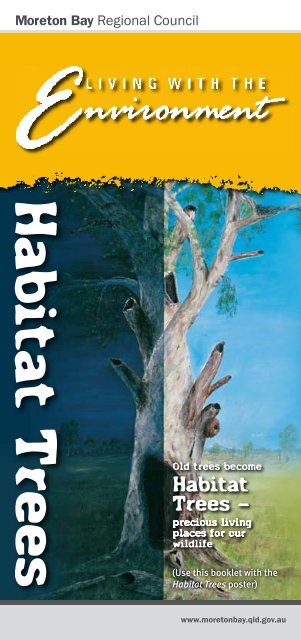
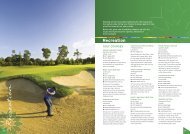

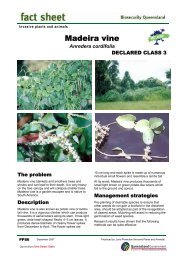
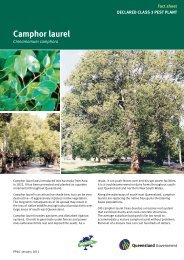


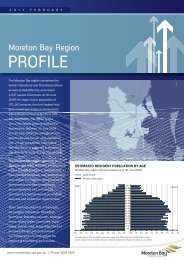
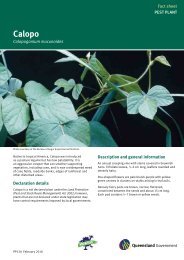

![Kumbartcho Brochure [PDF 540KB] - Moreton Bay Regional Council](https://img.yumpu.com/47220970/1/190x101/kumbartcho-brochure-pdf-540kb-moreton-bay-regional-council.jpg?quality=85)
